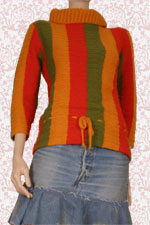Sweater
Sweater
A sweater, also known as a jumper in British English, is a piece of clothing intended to cover the upper part of the body, typically knitted from wool, cotton, or synthetic fibers. Sweaters are designed to provide warmth and are often worn in colder climates or during cooler parts of the year. They come in various styles, including pullovers, cardigans, and sweatshirts, each serving different aesthetic and functional purposes.
History[edit | edit source]
The history of the sweater dates back several centuries, with its origins rooted in the fishing and farming communities of the British Isles. These early sweaters were hand-knitted and designed to protect against the harsh weather conditions. The Aran sweater, originating from the Aran Islands off the west coast of Ireland, is a notable example, famous for its distinctive cable patterns which are said to symbolize the ropes of fishermen.
Types[edit | edit source]
Pullovers[edit | edit source]
Pullovers are sweaters that must be put on by pulling them over the head, as they do not open at the front. This style is known for its simplicity and versatility.
Cardigans[edit | edit source]
Cardigans open at the front, either with buttons or a zipper, making them easier to put on and take off. They were named after James Brudenell, the 7th Earl of Cardigan, who popularized the style during the 19th century.
Sweatshirts[edit | edit source]
Sweatshirts are a loose, long-sleeved, collarless pullover made from a heavy cotton or cotton-blend fabric, often fleece-lined for added warmth. Though similar to sweaters, they are distinguished by their athletic origins and casual style.
Materials[edit | edit source]
Sweaters are made from a variety of materials, each offering different levels of warmth, comfort, and durability. Wool, known for its excellent insulation properties, is a traditional choice. Cotton sweaters are lighter and more breathable, making them suitable for milder weather. Synthetic fibers, such as polyester and acrylic, provide durability and are often used in combination with natural fibers to improve the garment's shape retention and ease of care.
Cultural Significance[edit | edit source]
Sweaters have transcended their practical origins to become significant cultural symbols. The Christmas sweater, adorned with festive patterns and colors, has become a staple of holiday fashion in many Western countries. Similarly, the concept of the "sweater girl" in the 1940s and 1950s highlighted the garment's role in shaping fashion trends and ideals of beauty.
Care[edit | edit source]
Proper care is essential to maintaining the appearance and longevity of sweaters. Wool and cotton sweaters require gentle washing to avoid shrinking, while synthetic blends are generally more resilient. Many sweaters are recommended to be air-dried flat to prevent stretching and distortion.
See Also[edit | edit source]
Navigation: Wellness - Encyclopedia - Health topics - Disease Index - Drugs - World Directory - Gray's Anatomy - Keto diet - Recipes
Search WikiMD
Ad.Tired of being Overweight? Try W8MD's physician weight loss program.
Semaglutide (Ozempic / Wegovy and Tirzepatide (Mounjaro) available.
Advertise on WikiMD
WikiMD is not a substitute for professional medical advice. See full disclaimer.
Credits:Most images are courtesy of Wikimedia commons, and templates Wikipedia, licensed under CC BY SA or similar.
Contributors: Prab R. Tumpati, MD





